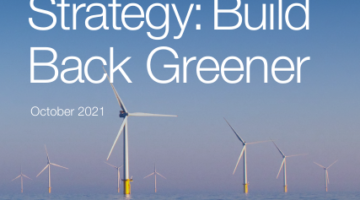
[Update: the figures on this page may be out of date. Find current rates here.]
The Effect of Temperature on Solar Panels
Many people now put solar PV panels on their roofs to take advantage of the feed in tariff and the export tariff available when you sell power back to the grid. For every 1kWh of electricity produced regardless of whether you use it in the home or sell it back to the grid you get 15.44 pence (if you sell it to the grid you get an additional 4.5 pence).
It goes without saying that maximising the amount of electricity you produce (i.e. number of kWhs) is key to ensuring healthy returns on investment and shortening the payback periods. So you can start not only making money by producing electricity via the subsidies available, but also use the electricity you produce to lower you bills.
One of the key factors impacting the amount of electricity your solar panels produce is the temperature at which they operate. It is easy to presume that more sun and therefore more heat result in more electricity but this is wrong.
Different solar panels react differently to the operating ambient temperature, but in all cases the efficiency of a solar panel decreases as it increases in temperature.
The impact of temperature on solar panel efficiency is known as the temperature coefficient.
The Temperature Coefficient
If you look at the data sheet provided by your solar panel manufacturer they will refer to a term normally described as the temperature coefficient pMax. This value, which is normally given in the form of negative percentage, reveals the impact of temperature on the panel.
Solar panels are power tested at 250C, so the temperature coefficient percentage illustrates the change in efficiency as it goes up or down by a degree. For example if the temperature coefficient of a particular type of panel is -0.5%, then for every 10C rise, the panels maximum power will reduce by 0.5%.
So on a hot day, when panel temperatures may reach 450C, a panel with a temperature coefficient of -0.5% would result in a maximum power output reduction of 10%. Conversely, if it was a sunny winter’s morning, the panels will actually be more efficient.
Each type of solar cell has a different temperature coefficient is detailed below:
- Both monocrystalline and polycrystalline cells have a temperature coefficient pMax of between -0.45% to -0.50%
- Amorphous based thin film panels have a rating of between -0.20% to -0.25%.
- The Hybrid solar cells currently on the market sit in the middle with a temperature coefficient pMax of between -0.32%
What can you do to stop your panels getting too hot?
Firstly in the process of making the panels, companies use a thermally conductive substrate is help vent excess heat from the glass layer.
Your solar panel installer will also try to ensure there is a free flow of air above and below the solar panels when they are mounted, by elevating the panels a few inches off the roof. In addition it is possible to add ventilation systems or fans to your solar PV system to help assist the movement of air around the panels.
However, it is important to ensure you try to install your panels where there is decent natural ventilation, just another factor to consider when choosing the position for your solar PV installation.












I would like to know , would solar panel sustain there body Shape at 55° – 60° without loosing their body shape and becoming Popdam shape.??
Are they suitable for very hot climates?
The above mentioned values are same for both roof-top and solar plants or not?
If the temperature becomes below 25 what will be happened. Is it also the efficiency decrease
Thank you concise and to the point. We have the problem of extreme heat I have personally measured roof top surface temperatures in excess of 60 degrees celsius in South Africa. We are using cool coatings as a means to mitigate against this.
This solar panel stole my girlfriend
Shut up
After the module technology is selected for an installation, there are several ways to minimize the negative effects of high temperatures:
• Install panels a few inches above the roof to allow convective air flow to cool the panels down.
• Ensure that panels are constructed with light-colored materials, to reduce heat absorption.
• Move components like inverters and combiners into the shaded area behind the array.
hi dear
i want to know if the environmental temperature is increase also solar output is increase or decrease for example th environmental temperature is 27 degree our solar output 20 watt if temperature is 20 degree our solar output increase or decrease please clear me..
hi dear
i want to know if the environmental temperature is increase also solar output is increase or decrease for example th environmental temperature is 27 degree our solar output 20 watt if temperature is 20 degree our solar output increase or decrease please clear to me..
Every big MNC’S now a day doing solar sysytem on their roof. bcoz of it they gets lot of electricity. thanks for sharing this apple’s informations with us. our Solar panel system company will also trying to do this better.
you said that for every temperature celcium above the MAT (25 c) is decreasing the efficiency for 0,5% or the total output of 0.5%? because the efficiency of the absorbed light from the sun is lets say 15% and the efficiency of the total amount of energy generated is 100%..
Your article is really interesting and informative too, Thank you for sharing this with us. I totally agree with you in this, If we see today electricity cost is raising day by day so we can go for solar energy where we are going to do an investment and in return we will get a lot of benefits like saving electricity, reducing electricity bill and as of course our place cost will be increased too. Your article was worth reading, Keep sharing such things.
• Experiment 1: PV characteristics.
– E-I Curve.
– Maximum Power Point.
– Open Circuit voltage & Short Circuit current.
– PV panels Series and parallel connection (Simulation).
• Experiment 2: Effect of Temperature on Solar Panel Performance.
– Effect of Temperature on output voltage, current and power.
• Experiment 3: Storing Energy from Solar panels into Batteries.
– Battery Charging using PV module.
– Battery-PV connected in the Dark.
• Experiment 4: Design PV standalone system.
– PV module with charger controller, battery and isolation switch.
• Experiment 5: Setting Up basic PV system with DC & AC load.
• Experiment 6: Voltage-Versus-Speed Characteristics of a Wind Turbine Generator
– Construction of wind turbine generator.
– Voltage and frequency relationship with the speed of rotation.
• Experiment 7: Torque-Versus-Current Characteristics of a Wind Turbine Generator
– Torque versus current curve.
• Experiment 8: Power versus Wind Speed.
• Experiment 9: Storing the Energy Produced by Wind Turbines in Batteries.
– Maximum charge voltage of the wind turbine controller.
– Partially discharging the batteries in the Lead-Acid Battery Pack.
– Battery overcharging protection.
Which type of solar Panel (mono, poly or thin film) should I go for in areas with high temperatures around 35-40degC?